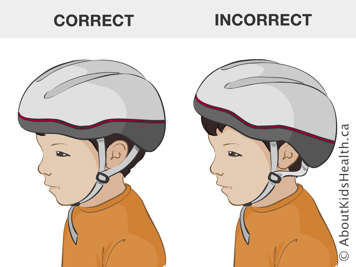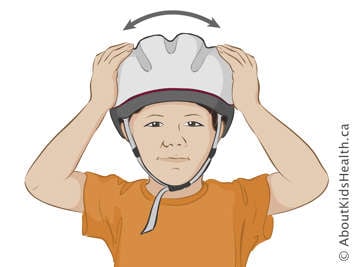Making sure that your child always wears a helmet when they are cycling or playing particular sports is the best way to prevent head injuries. To do this, it is important to know how to fit a helmet correctly and teach your child why it is important to use a helmet for protection.
How to fit a helmet correctly
Helmets that do not fit or that are not fastened correctly are no help to the brain. Use the tips below to make sure that your child is wearing a helmet properly.
A helmet must not slip forward or back. The frontal lobes, a part of the front of the brain that is important for memory and decision-making, and occipital lobes, a crucial vision centre at the back of the brain, need protection. This can only be achieved when the helmet is centred on your child's head.

The helmet must fit snugly, but not tightly and not sit too high on the head. It should cover the forehead and must not slip from side to side. The straps from the front and back of the helmet should form a 'V' around the ears and meet just under the ear. When fastened, the helmet straps should allow the mouth to open to drink or shout, but the strap under the chin must not be loose.

Do not buy a large helmet and let your child grow into it. Make sure that the helmet fits perfectly at the time you buy it. You can adjust the fit for comfort using the small foam pads included with the helmet.
Take a look at this video for more tips.
Your child should not wear anything under the helmet, such as a hat. Helmets are designed to provide the most effective protection from head injuries when they are worn directly next to the head. If you are concerned about keeping your child warm during the winter, you can buy helmets with outer warmth protection that help keep children's heads warm during activities.
How to get your child to wear a helmet
Your child's attitude can be a barrier to wearing a helmet, but it does not offer any protection against injury. Many children insist they do not need to wear a safely-fitted helmet. Some older children might worry about messing up their hair or might say that they do not need to wear a helmet because none of their friends do. However, there is a lot you can do to help your child commit to wearing a helmet.
Set a good example
As a parent, you are a role model to your children. Your actions could be your child’s best protection against head injury. Research shows that when parents wear a helmet, their children are more likely to want to wear one. Demonstrate the importance of wearing a helmet by wearing one every time you ride your bike. Most professional athletes use helmets when taking part in sports.
Start early and be consistent
Get your child used to wearing a helmet as soon as they start riding a tricycle or bicycle. If you allow your child to ride occasionally without a helmet, they will not believe that helmet use is really important. Helmets should be worn on all rides, no matter how short. Tell your child that they will not be able to use their bicycle unless they wear a helmet.
Talk to your child about why you want them to protect their head
Unlike your elbows or your ribs, your brain is you. It stores everything you think, feel and experience. Children often do not fear death, but they may understand the dangers of their sport better if you discuss the loss of mental abilities that can come with repeated concussions. These can include learning difficulties, social problems and attention disorders. Even a single serious brain injury can have lifelong effects on a person's thoughts and emotions.
Demonstrate the importance of a helmet
As part of science class, many kids take part in the well-known "egg drop" experiment. Kids build a protective structure that allows a raw egg to survive a fall of almost two metres.
If your child is working on a similar project, discuss how egg protection is very similar to head protection. You can also mention this to your child's teacher; it is a real opportunity to combine physics with health promotion.
A small watermelon works well for the experiment too. Try dropping one from a height of two metres. Then drop another watermelon that is protected with a helmet. Your child will easily see benefits of helmets right away.